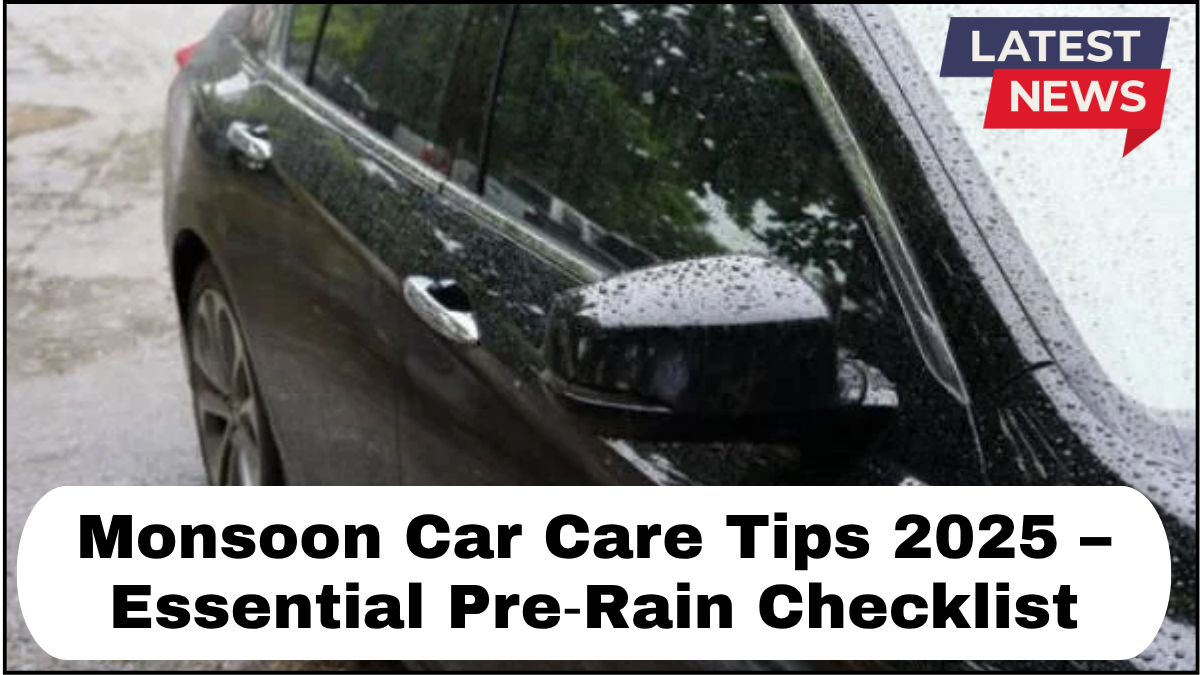As the skies turn grey and the first drops begin to fall, every car owner in India knows it’s time to shift gears and prepare for the monsoon. Driving in the rain isn’t just about slower speeds; it’s about keeping your vehicle ready for unpredictable weather. Here’s your complete guide to Monsoon Car Care 2025 Tips to ensure your ride stays safe, smooth, and hassle-free this rainy season.

1. Inspect and Replace Wiper Blades
Your windshield wipers are your first line of defense in heavy rain. Worn-out blades cause streaks, reduce visibility, and are hazardous during downpours. Check for cracks or brittleness. If they squeak or skip, replace them immediately. It’s wise to do this at the start of the monsoon, not mid-season when you’re caught in a storm.
2. Test Headlights, Brake Lights, and Indicators
Visibility can drop drastically during a downpour. Make sure all external lights are fully functional. Clean foggy lenses, replace fused bulbs, and ensure your headlights are correctly aligned. Also, check that brake lights and turn indicators are clearly visible. Functioning lights are critical for both your safety and the safety of others on the road.
3. Check Tyre Tread and Pressure
Tyres with poor tread lose grip on wet roads, increasing the risk of skidding or aquaplaning. The minimum legal tread depth in India is 1.6mm, but for monsoon driving, more tread depth means better water displacement. Also, ensure proper tyre pressure. Underinflated tyres can reduce control, while overinflated ones may lose grip.
4. Examine the Braking System
Brakes are more prone to wear during the rainy season due to moisture. If you notice any delay in braking, squealing noises, or a spongy pedal, get your brake pads, rotors, and fluid checked by a professional. Effective braking is non-negotiable for monsoon car maintenance in India.
5. Ensure Proper Drainage
Blocked drainage channels around your car’s windshield, sunroof, or boot can lead to water ingress and interior damage. Clean these areas and remove any debris or leaves. Water accumulation can also lead to electrical faults and foul odors if not addressed early.
6. Treat Underbody Rust Protection
Monsoon means constant exposure to mud, water, and grime—a recipe for underbody rust. Consider an anti-rust coating if your car doesn’t already have one. This is particularly important for older vehicles and those frequently driven through water-logged areas.
7. Protect the Car Battery
Humidity and fluctuating temperatures can shorten battery life. Check battery terminals for corrosion and ensure the battery is securely fastened. If your battery is nearing the end of its lifespan, it might be wise to replace it before the rains hit hard.
8. Maintain the HVAC System
A fogged-up windshield can be just as dangerous as poor wipers. Make sure your HVAC (Heating, Ventilation, and Air Conditioning) system is working properly to help defog windows and keep the cabin dry and comfortable.
9. Waterproof the Interiors
Invest in waterproof floor mats and seat covers. This keeps your car’s interiors clean and odor-free, especially when passengers step in with wet clothes or muddy shoes. Avoid fabric mats, which absorb water and breed mold.
10. Stock Up on Emergency Essentials
Always keep an emergency kit in your car during the monsoon. This should include a flashlight, first-aid kit, a tow rope, a raincoat, basic tools, jumper cables, and an extra phone charger. Preparedness makes all the difference when stranded in rain or floods.
11. Monitor Engine Performance
Heavy rains can lead to water entering the engine through the air intake, especially if you drive through deep puddles. Avoid driving through waterlogged roads, and if you must, go slow. Also, consider installing a rain guard or snorkel for SUVs if monsoon flooding is common in your area.
12. Keep the Fuel Tank Topped Up
A nearly empty tank can lead to condensation forming inside, contaminating the fuel. Keeping your tank above half-full can reduce this risk and is also practical in case you get stuck in traffic during heavy rain.
FAQs on Monsoon Car Care 2025 Tips
Q1. How often should I replace wiper blades during the monsoon?
At least once every year or as soon as they start to leave streaks or make noise.
Q2. Is anti-rust coating necessary for new cars?
Most new cars come with factory rust protection, but if you live in a flood-prone area, an additional coating offers extra security.
Q3. Can I use regular floor mats during the rainy season?
It’s better to switch to waterproof mats. Regular fabric mats soak water and can develop mold or bad odors.
Q4. What should I do if my car stalls in a waterlogged area?
Turn off the engine immediately. Starting it can cause hydrolock. Call roadside assistance and do not try to push the vehicle yourself.
Q5. How do I know if my tyres are monsoon-ready?
Check for at least 2mm of tread depth and no visible cracks or uneven wear.
click here to learn more